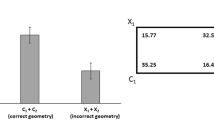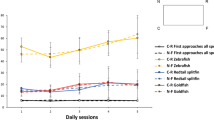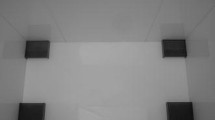Abstract
It has been shown that children and non-human animals seem to integrate geometric and featural information to different extents in order to reorient themselves in environments of different spatial scales. We trained fish (redtail splitfins, Xenotoca eiseni) to reorient to find a corner in a rectangular tank with a distinctive featural cue (a blue wall). Then we tested fish after displacement of the feature on another adjacent wall. In the large enclosure, fish chose the two corners with the feature, and also tended to choose among them the one that maintained the correct arrangement of the featural cue with respect to geometric sense (i.e. left-right position). In contrast, in the small enclosure, fish chose both the two corners with the features and the corner, without any feature, that maintained the correct metric arrangement of the walls with respect to geometric sense. Possible reasons for species differences in the use of geometric and non-geometric information are discussed.







Similar content being viewed by others
References
Brown C, Braithwaite VA (2005) Effects of predation pressure on the cognitive ability of the poeciliid Brachyraphis episcope. Behav Ecol 16:482–487
Burt de Perera T (2004) Spatial parameters encoded in the spatial map of the blind Mexican cave fish, Astyanax fasciatus. Anim Behav 68:291–295
Cheng K (1986) A purely geometric module in the rat's spatial representation. Cognition 23:149–178
Cheng K, Newcombe NS (2005) Is there a geometric module for spatial orientation? Squaring theory and evidence. Psychon Bull Rev 12:1–23
Deipolyi A, Santos L, Hauser MD (2001) The role of landmarks in cotton-top tamarin spatial foraging: evidence for geometric and non-geometric features. Anim Cogn 4:99–108
Gouteux S, Thinus-Blanc C, Vauclair J (2001) Rhesus monkeys use geometric and nongeometric information during a reorientation task. J Exp Psychol: Gen 130:505–519
Gray ER, Bloomfield LL, Ferrey A, Spetch ML, Sturdy CB (2005) Spatial encoding in mountain chickadees: features overshadow geometry. Biol Lett 1:314–317
Hermer L, Spelke ES (1994) A geometric process for spatial reorientation in young children. Nature 370:57–59
Hermer L, Spelke ES (1996) Modularity and development: the case of spatial reorientation. Cognition 61:195–232
Hupbach A, Nadel L (2005) Reorientation in a rhombic environment: no evidence for an encapsulated geometric module. Cogn Dev 20:279–302
Kelly DM, Spetch ML, Heth CD (1998) Pigeons (Columba livia) encoding of geometric and featural properties of a spatial environment. J Comp Psychol 112:259–269
Learmonth AE, Nadel L, Newcombe NS (2002) Children's use of landmarks: implication for modularity theory. Psychol Sci 13:337–341
Learmonth AE, Newcombe NS, Huttenlocher J (2001) Toddlers’ use of metric information and landmarks to reorient. J Exp Child Psychol 80:225–244
Meyer MK, Wischnath L, Foerster W (1985) Lebendgeba¨rende Zierfishe: Arten der Welt. Mergus Verlag, Melle
Nadel L, Hupbach A (2006) Cross-species comparisons in development: the case of the spatial “module”. In: Johnson MH, Munakata Y (eds) Attention and Performance XXI. Oxford University Press, Oxford, pp 499–511
Sovrano VA, Vallortigara G (2006) Dissecting the geometric module: a sense-linkage for metric and landmark information in animals’ spatial reorientation. Psych Sci 17
Sovrano VA, Bisazza A, Vallortigara G (2001) Lateralization of response to social stimuli in fishes: a comparison between different methods and species. Physiol Behav 74:237–244
Sovrano VA, Bisazza A, Vallortigara G (2002) Modularity and spatial reorientation in a simple mind: encoding of geometric and nongeometric properties of a spatial environment by fish. Cognition 85:B51–B59
Sovrano VA, Bisazza A, Vallortigara G (2003) Modularity as a fish views it: conjoining geometric and nongeometric information for spatial reorientation. J Exp Psychol: Anim Behav Process 29:199–210
Sovrano VA, Bisazza A, Vallortigara G (2005) Animals’ use of landmarks and metric information to reorient: effects of the size of the experimental space. Cognition 97:121–133
Sovrano VA, Rainoldi C, Bisazza A, Vallortigara G (1999) Roots of brain specializations: preferential left-eye use during mirror-image inspection in six species of teleost fish. Behav Brain Res 106:175–180
Spelke ES (2000) Core knowledge. Am Psychol 55:1233–1243
Spelke ES (2003) What makes us smart. Core knowledge and natural language. In: Gentner D, Goldin-Meadow S (eds) Language in mind. Advances in the study of language and thought. MIT Press, Cambridge, MA, pp 277–311
Spelke ES, Tsivkin S (2001) Initial knowledge and conceptual change: space and number. In: Bowerman M, Levinson S (eds) Language acquisition and conceptual development. Cambridge University Press, Cambridge, UK
Vallortigara G (2004) Visual cognition and representation in birds and primates. In: Rogers LJ, Kaplan G (eds) Vertebrate comparative cognition: are primates superior to non-primates? Kluwer Academic/Plenum Publishers, Boston, New York, pp 57–94
Vallortigara G (2006) The cognitive chicken: visual and spatial cognition in a non-mammalian brain. In: Wasserman EA, Zentall TR (eds) comparative cognition: experimental explorations of animal intelligence. Oxford University Press, Oxford, UK, pp 41–58
Vallortigara G, Sovrano VA (2002) Conjoining information from different modules: a comparative perspective. Behav Brain Sci 25:701–702
Vallortigara G, Feruglio M, Sovrano VA (2005) Reorientation by geometric and landmark information in environments of different size. Dev Sci 8:393–401
Vallortigara G, Pagni P, Sovrano VA (2004) Separate geometric and non-geometric modules for spatial reorientation: evidence from a lopsided animal brain. J Cogn Neurosci 16:390–400
Vallortigara G, Zanforlin M, Pasti G (1990) Geometric modules in animal's spatial representation: a test with chicks. J Comp Psychol 104:248–254
Vargas JP, Lopez JC, Salas C, Thinus-Blanc C (2004) Encoding of geometric and featural spatial information by Goldfish (Carassius auratus). J Comp Psychol 118:206–216
Wang RF, Spelke ES (2002) Human spatial representation: insights from animals. Trends Cogn Sci 6:376–382
Acknowledgements
We thank Rosa Damiani for help with training of the animals. G.V was supported by grants MIUR Cofin 2004, 2004070353_002 “Intel-lat” and MIPAF “Ben-o-lat”.
Author information
Authors and Affiliations
Corresponding author
Rights and permissions
About this article
Cite this article
Sovrano, V.A., Bisazza, A. & Vallortigara, G. How fish do geometry in large and in small spaces. Anim Cogn 10, 47–54 (2007). https://doi.org/10.1007/s10071-006-0029-4
Received:
Revised:
Accepted:
Published:
Issue Date:
DOI: https://doi.org/10.1007/s10071-006-0029-4




